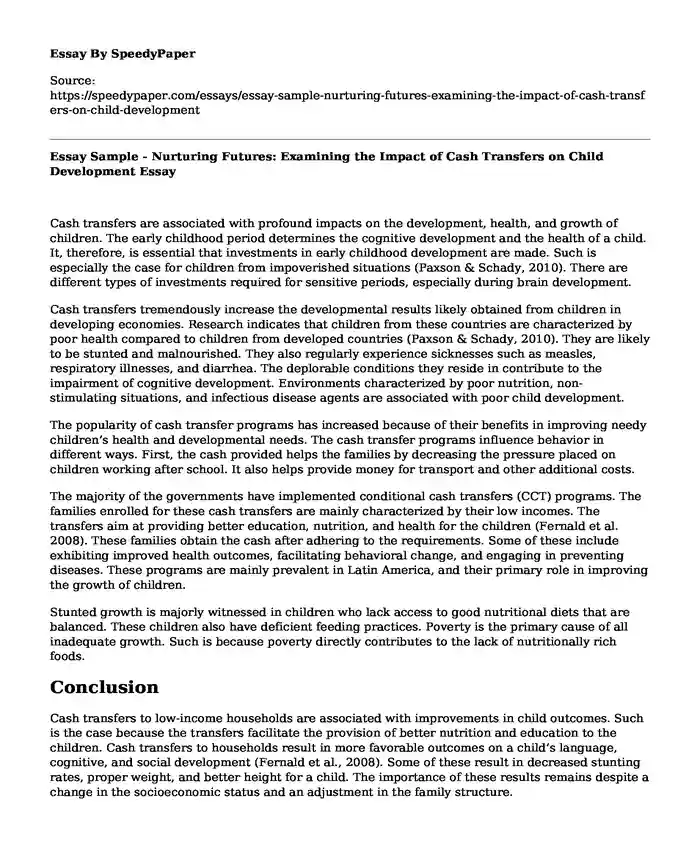
| Type of paper: | Essay |
| Categories: | Child development |
| Pages: | 3 |
| Wordcount: | 672 words |
Cash transfers are associated with profound impacts on the development, health, and growth of children. The early childhood period determines the cognitive development and the health of a child. It, therefore, is essential that investments in early childhood development are made. Such is especially the case for children from impoverished situations (Paxson & Schady, 2010). There are different types of investments required for sensitive periods, especially during brain development.
Cash transfers tremendously increase the developmental results likely obtained from children in developing economies. Research indicates that children from these countries are characterized by poor health compared to children from developed countries (Paxson & Schady, 2010). They are likely to be stunted and malnourished. They also regularly experience sicknesses such as measles, respiratory illnesses, and diarrhea. The deplorable conditions they reside in contribute to the impairment of cognitive development. Environments characterized by poor nutrition, non-stimulating situations, and infectious disease agents are associated with poor child development.
The popularity of cash transfer programs has increased because of their benefits in improving needy children’s health and developmental needs. The cash transfer programs influence behavior in different ways. First, the cash provided helps the families by decreasing the pressure placed on children working after school. It also helps provide money for transport and other additional costs.
The majority of the governments have implemented conditional cash transfers (CCT) programs. The families enrolled for these cash transfers are mainly characterized by their low incomes. The transfers aim at providing better education, nutrition, and health for the children (Fernald et al. 2008). These families obtain the cash after adhering to the requirements. Some of these include exhibiting improved health outcomes, facilitating behavioral change, and engaging in preventing diseases. These programs are mainly prevalent in Latin America, and their primary role in improving the growth of children.
Stunted growth is majorly witnessed in children who lack access to good nutritional diets that are balanced. These children also have deficient feeding practices. Poverty is the primary cause of all inadequate growth. Such is because poverty directly contributes to the lack of nutritionally rich foods.
Conclusion
Cash transfers to low-income households are associated with improvements in child outcomes. Such is the case because the transfers facilitate the provision of better nutrition and education to the children. Cash transfers to households result in more favorable outcomes on a child’s language, cognitive, and social development (Fernald et al., 2008). Some of these result in decreased stunting rates, proper weight, and better height for a child. The importance of these results remains despite a change in the socioeconomic status and an adjustment in the family structure.
Both unconditional and conditional cash transfers also increase the number of children attending school (Robertson et al., 2013). The number of children attending school who have a birth certificate increases with conditional cash transfers. The conditional cash transfer is vital in altering household behaviors (Morris et al., 2004). Families provided with cash transfers reported improved hemoglobin levels, and the children also received deworming programs. Cash transfers contribute to better child development because they facilitate and increase the rate at which children get enrolled in schools and receive medical care (Paxson & Schady, 2010). Cash transfers have also decreased the overweight of children. This is the case because of the availability of nutritionally rich foods (Morris et al., 2004).
References
Paxson, C., Schady, N. (2010). Does money matter? The effects of cash transfers on child development in Rural Ecuador. The University of Chicago.
Eaton, J. W., Makoni, J. C., Schumacher, C., Crea, T. M. (2013). Effects of unconditional and conditional cash transfers on child health and development in Zimbabwe: a cluster-randomized trial. The Lancet.
Morris, S. S., Olinto, P., Flores, R., Nilson, E. A. F., Figueiro, A. C. (2004). Conditional cash transfers are associated with a small reduction in the rate of weight gain of preschool children in Northeast Brazil. Community and International Nutrition.
Fernald, L. C. H., Gertler, P. J., Neufeld, L. M. (2008). Role of cash in conditional cash transfer programs for child health, growth and development: an analysis of Mexico’s Oportunidades. The Lancet, 371.
Cite this page
Essay Sample - Nurturing Futures: Examining the Impact of Cash Transfers on Child Development. (2024, Jan 17). Retrieved from https://speedypaper.com/essays/essay-sample-nurturing-futures-examining-the-impact-of-cash-transfers-on-child-development
Request Removal
If you are the original author of this essay and no longer wish to have it published on the SpeedyPaper website, please click below to request its removal:
- Free Essay on Working Memory Functions in Children
- Child Development Essay Example
- Essay Example on Norman Knight Center for Clinical and Professional Development
- Observation Essay Example: Child Play Levels and Activities
- Essay Example: Improving Pronunciation of the Letter (P) Among Saudi English Learners
- Essay on Law and Order: The Secret to Human Development in Modern Times
- Paper Example. Practical Research on Mobile-Assisted Language Teaching in China Universities
Popular categories




